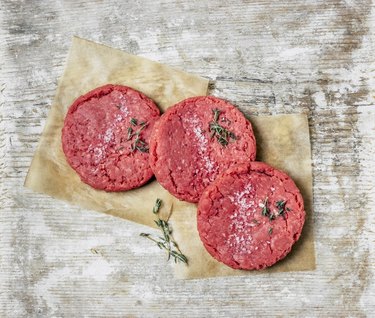
Red meat may not be as demonized in the diet as carbohydrates have become, but you'll still see experts demanding that you cut back on your intake. This can be a challenge, especially if you are contemplating a low-carb lifestyle. It can also be confusing to figure out what "cut back" even means. The good news is that the cautions against red meat are old news, and as long as you keep to appropriate portion sizes and don't overdo the frequency, you can enjoy all kinds of meat as part of a fit and healthy lifestyle.
Recommended Daily Meat Intake
Video of the Day
Your recommended daily intake of poultry, meat and eggs should be eight to nine servings per week, or just more than one serving per day, according to the meat serving size chart compiled by the American Heart Association. At least two to three servings of meat per week should actually be fish, especially those high in omega-3 fatty acids, such as salmon. One serving of beef, pork or fish is about 3 ounces. A 3-ounce serving size of chicken should be estimated without the skin or bones because you will not be eating those. One serving of eggs is one whole egg or two egg whites. Meat should have all visible fat trimmed before you cook it. Chicken may be cooked with the skin on, but remove it before serving to keep your fat and calorie counts down.
Video of the Day
Read more: The Health Benefits of Eating Red Meat
Types of Meat to Enjoy
Most of the studies suggesting that red meat, in particular, is bad for you were done earlier than the 1990s, according to Dr. Kevin Campbell writing for U.S. News & World Report. Beef today is much leaner than in the past. Pork, turkey and chicken are also good choices, and game meats, such as venison, also tend to be very lean. When choosing fish, make sure to include fattier fish, such as salmon and sardines, which are packed with heart-healthy omega-3 fatty acids. Grill, roast or broil your meats to avoid adding extra fat and calories, or saute them in a pan coated very lightly with a thin film of olive oil.
Read more: Meat That Is Good for Weight Loss
How to Estimate Portion Sizes
Portion control is important, according to Duke Diet & Fitness Center, because you have no way of monitoring and controlling your caloric intake if you're just randomly piling food on your plate. Appropriate food serving sizes are much smaller than what you generally get at a restaurant, and those large servings influence how you view portion sizes when you're at home. It is not practical to carry measuring cups or a food scale with you when dining out, so it's a good idea to learn how to eyeball your portion sizes. This is easily accomplished by using the palm portion method, or as the fitness experts at Shape suggest, compare your portions to familiar objects. In the case of meat, poultry or fish, one portion should be about the same size and shape as a standard deck of playing cards.
Read more: The Secret to Portion Control